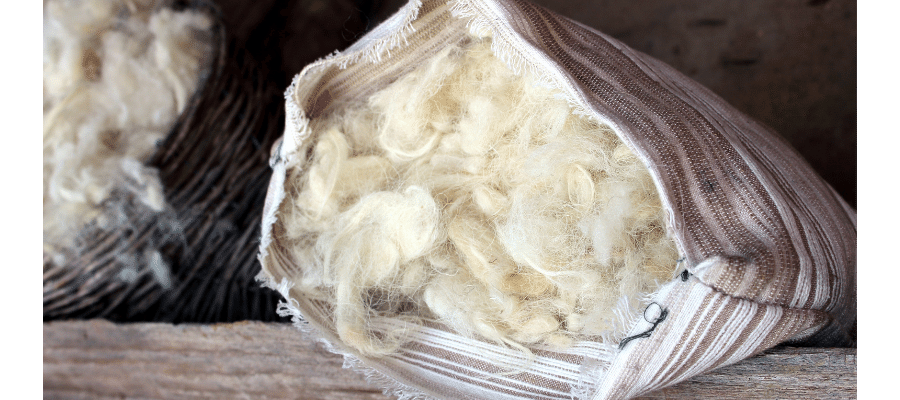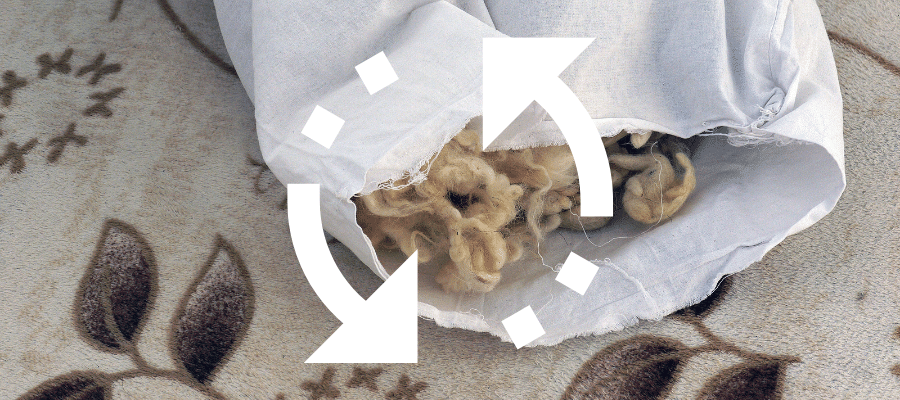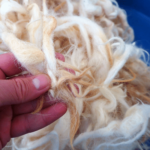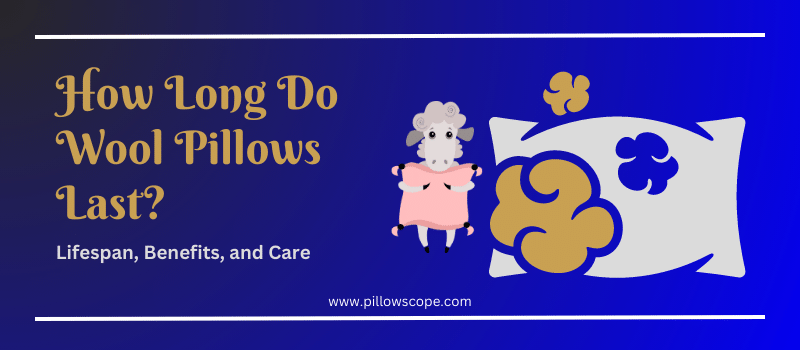What are Wool Pillows?
Wool pillows are a popular choice due to their unique properties. They are made from sheep’s fleece, known for their excellent temperature regulation, moisture-wicking capabilities, and hypoallergenic nature. Wool pillows provide a comfortable and healthy sleeping environment, making them a favorite among those who value quality sleep.
Benefits of Wool Pillows
Wool pillows offer several benefits that set them apart from other pillows. Indeed, here are some of the critical benefits of wool pillows:

Temperature Regulation:
Wool is an excellent insulator. It can help to regulate body temperature by drawing moisture away from the body when it’s hot and providing warmth when it’s cold. It makes wool pillows an excellent choice for all seasons.
Hypoallergenic:
Wool naturally resists dust mites, mold, and mildew, which are common allergens. This makes wool pillows an excellent choice for those with allergies or asthma.
Comfort:
Wool pillows are known for their comfort. They are soft yet supportive, providing a comfortable place to rest your head. Wool is very conformable, so it can support your head and neck while also reducing pressure points.
Durability:
Wool is a robust material that can last for years with proper care. Unlike synthetic materials, wool doesn’t break down as quickly, so your wool pillow will maintain its shape and support for longer.
Environmentally Friendly:
Wool is a renewable resource, and the production of wool pillows has a lower environmental impact compared to synthetic pillows. Moreover, wool pillows are biodegradable at the end of their life, reducing their environmental impact.
Moisture Wicking:
Wool can absorb significant moisture without feeling wet. It makes wool pillows a great option for those who tend to sweat during the night, as they can help to keep you dry and comfortable.
Fire Resistant:
Wool is naturally fire-resistant, making wool pillows a safer choice than other types.
Easy to Care:
Wool pillows are easy to care for. They don’t need to be washed as often as other types of pillows, and when they do need to be cleaned, it can usually be done with a simple spot cleaning.
How Long Do Wool Pillows Last?
Factors Affecting the Lifespan of Wool Pillows:
The lifespan of wool pillows can be affected by several factors. These include the quality of the wool, how the pillow is used, and how well it is cared for. Regular cleaning and proper storage can significantly extend the life of a wool pillow. Here are some guidelines to increase the lifespan of wool pillows:
- Quality: Higher-quality wool pillows, made with better materials and construction, tend to last longer than cheaper, lower-quality options. Investing in a well-made cushion can extend its longevity.
- Maintenance: A wool pillow needs regular care and maintenance to last as long as possible. If you fluff and turn the pillow often, it will keep its shape and wear more evenly. A pillow protector or pillowcase can also keep the pillow clean and free of stains and oils for longer.
- Cleaning: Following the manufacturer’s cleaning instructions is essential to keep the wool pillow fresh and in good condition. Some wool pillows can be machine-washed, while others require spot or professional cleaning. Regularly cleaning the pad as needed will help it retain its loft and comfort.
- Frequency of Use: The more often you use the pillow, the more wear and tear it will experience. Pillows used every night generally have a shorter lifespan than those used occasionally.
- Changes in Comfort: Your preferences for pillow firmness or loft may change over time. Even if a wool pillow remains structurally sound, you may decide to replace it if it no longer provides the level of comfort you desire.
Average Lifespan of Wool Pillows:
On average, wool pillows should be replaced every one to three years. It is because, over time, the pillow can accumulate skin cells, body oils, and sweat, which can lead to staining and odor. The pillow can also lose shape and support, leading to discomfort and poor sleep quality.
Signs Your Wool Pillow Needs Replacement

Noticeable Lumps:
One clear sign that your wool pillow needs replacing is the presence of noticeable lumps in the filler material. These lumps can cause discomfort and disrupt your sleep.
Permanent Stains:
Permanent stains from body sweat and oil are another sign that it’s time to replace your wool pillow. These spots are unattractive and can produce a foul stench.
Aches and Pains:
If you wake up with aches and pains in your neck or shoulder area, it may be a sign that your wool pillow is no longer providing the support you need.
Allergy Symptoms:
Frequent sneezing or other allergy symptoms can also indicate that your wool pillow needs to be replaced. While wool is naturally hypoallergenic, it can still accumulate allergens like dust mites over time.
Tips for Replacing Your Wool Pillow
Here are some tips to consider when it’s time to replace your wool pillow:

Check the Quality:
When replacing your wool pillow, ensure that you’re choosing a high-quality product. Look for pillows that are made from 100% pure and organic wool. These pillows will provide the full benefits of wool and are free from synthetic materials.
Consider Your Sleeping Position:
Your sleeping position is a key factor in determining which type of pillow will best support you. Side sleepers generally need a firmer and thicker pillow to support the neck; back sleepers might prefer a medium-thick pillow, while stomach sleepers often benefit from a softer, thinner pillow.
Size and Shape Matter:
The size and shape of your pillow can significantly impact your comfort and sleep quality. Make sure to choose a pillow that suits your body size and the dimensions of your bed.
Firmness Level:
The level of firmness is mainly based on your preference. However, if you need more clarification, consider how you sleep. A softer wool pillow may be more comfortable if you sleep on your stomach or your back. Firmer wool pillows, often blended with other materials like polyester, may work best for side sleepers.
Budget:
Wool pillows can be more expensive than other types of pillows due to their numerous benefits. However, consider it as an investment in your sleep health. If budget is a concern, you can find less expensive alternatives by buying wool pillows blended with synthetic materials.
Pillow Covers:
Consider buying an external cover for your wool pillow. This can protect your pillow from sweat, oil, and skin cells, prolonging its lifespan. Pillow covers are easy to take off and wash, making them a practical choice for maintaining your pillow.
Care Instructions:
If you want your wool pillow to last as long as possible, be sure to follow the manufacturer’s care recommendations. This often includes spot cleaning and airing out the pillow regularly.
Note: Remember, a good pillow is critical to a good night’s sleep, so take the time to choose the best wool pillow for your needs.
Can Wool Pillows Be Washed and How to Wash Them?
Yes, wool pillows can be washed, but it’s essential to do so carefully to maintain their quality and longevity. Here’s a step-by-step guide on how to wash your wool pillows:

Check the Care Label:
Before you begin, always check the care label on your wool pillow. Some wool pillows may be machine washable, while others only require hand washing or spot cleaning.
Preparation:
If your wool pillow has a removable cover, remove it before washing. The body can usually be washed separately according to its care instructions.
Hand Washing:
- If your wool pillow requires hand washing, fill a tub with lukewarm water and add mild, wool-safe detergent.
- Just submerge the pillow in water and squeeze it gently to dispense the detergent into the wool to wash the pillow.
- Avoid twisting or wringing the pillow, which can damage the wool fibers.
Rinsing:
Drain the soapy water and refill the tub with clean, lukewarm water. Submerge the pillow and squeeze it gently to rinse out the detergent. You may need to repeat this process several times until all the soap is removed.
Drying:
- Press it gently to remove excess water once the pillow is thoroughly rinsed.
- Do not wring out the pillow.
- Place the pillow on a dry, clean towel and roll it up to increase the amount of water it can absorb.
- Unroll the towel and leave the pillow to air dry flat in a well-ventilated area away from direct sunlight.
- Avoid using a dryer because this might cause the wool to shrink and get damaged.
Fluffing:
Once the pillow is completely dry, fluff it gently to restore its loft.
Note: Remember, it’s always best to spot clean wool pillows whenever possible to avoid the need for frequent washing. If you need more clarification about washing your wool pillow, consider taking it to a professional cleaner who specializes in wool products.
Wool Pillows for Different Sleeping Positions
Wool pillows can be an excellent choice for all sleepers due to their natural loft and ability to maintain shape. However, the ideal wool pillow can vary depending on your preferred sleeping position:

Side Sleepers:
They generally require a firmer and thicker pillow to align their neck and spine. The space between the shoulder and the head can be filled by a high-loft wool cushion, providing the necessary support and helping to minimize neck strain.
Back Sleepers:
Back sleepers need a pillow that supports the spine’s natural curvature while cradling the head. A medium-loft wool pillow can provide the right balance of support and softness. It’s also beneficial if the pillow has a curve to support the neck.
Stomach Sleepers:
Most of the time, people who sleep on their stomachs need a softer, thinner pillow so their neck doesn’t get too high, which can cause neck strain. A low-loft wool pillow provides cushioning without elevating the head too much.
Combination Sleepers:
Combination sleepers, who change positions throughout the night, may benefit from a medium-firm wool pillow with a medium to high loft. This can provide a good balance of support and flexibility for various sleeping positions.
Note:
Remember, personal comfort is the most crucial factor when choosing a pillow. Finding the perfect wool pillow for your needs may take trial and error. Always check the return policy when buying a new pillow, so you can exchange it if it doesn’t provide the proper support or comfort for your sleeping position.
Conclusion:
Wool pillows are a great investment for quality sleep. However, like all pillows, they don’t last forever. Regular replacement and proper care can ensure you continue enjoying your wool pillow’s benefits for as long as possible.
FAQs.
Are wool pillows hypoallergenic?
Yes, wool pillows are naturally hypoallergenic and resistant to dust mites.
What should I consider when replacing my wool pillow?

Consider choosing a 100% pure organic wool pillow, and consider your sleeping position and body size.
How can I extend the lifespan of my wool pillow?

Regular cleaning and using an external cover can help extend the lifespan of your wool pillow.
What are the signs that my wool pillow needs to be replaced?
Signs include noticeable lumps, permanent stains, waking up with aches and pains, and frequent allergy symptoms.
How often should I replace my wool pillow?

On average, wool pillows should be replaced every one to three years.

